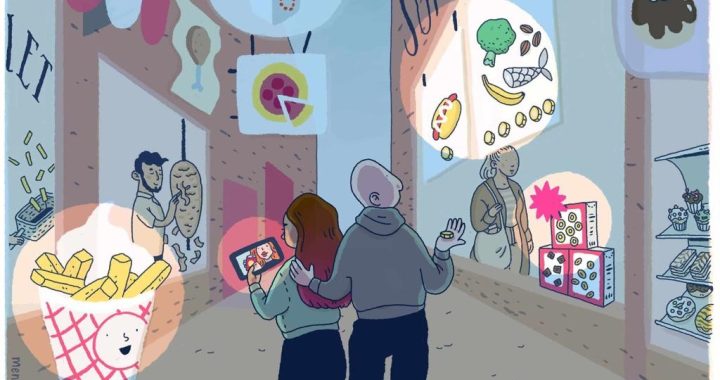Childhood obesity is on the rise across the world. Between 1975 and 2016, the prevalence of overweight and obesity in children has increased from 4% to 18% globally.1 The increase is observed almost everywhere (low- and middle-income countries, and high-income countries), particularly within urban area.2 In 2016, more than 340 million children and adolescents (5-19 years) were living with overweight or obesity.1 Over 39 million children under the age of 5 were estimated to be overweight or obese in 2020, about 25% of them in Africa alone.3 The situation in Ghana, as reported in the recent Demographic and Health Survey conducted in 2014, shows that an estimated 3% of Ghanaian children are overweight or obesity.4 Recent local studies report a very high prevalence of overweight/obesity among Ghanaian children. Ranging from 16%5,6 to 46%7, the rates are significantly higher in urban Ghana than in rural Ghana, and in females compared to males. In one study, 42% of male children compared to 52% of female children were overweight.7
It is a known fact that the early onset of overweight and obesity in children and adolescents has devastating lifelong consequences for their development and wellbeing. Psychological effects such as weight stigma, social isolation, and low self-esteem have been reported among obese and overweight children and adolescents.8 Also, children who are overweight and obese have increased present and future risk of non-communicable diseases (NCDs) including heart disease, diabetes, and some cancers, which may increase morbidity and mortality.9 Childhood obesity, just like other diet-related NCDs, are often driven by modifiable risk factors, such as increased consumption of unhealthy foods and beverages and physical inactivity.10
Today’s food environment makes it very difficult for children to have a healthy diet. The food environment in which children find themselves provides them with considerably more unhealthy options, such as ultra-processed foods than healthy foods like fresh fruits, vegetables, and whole grains.11 Also happening concurrently is the deliberate effort by the food and advertising industries to ubiquitously expose food products to their consumers through aggressive persuading food marketing activities.12 Some of these marketing strategies have been tagged as predatory marketing. Fraser et al., defined predatory marketing as “marketing that promotes unhealthy products to vulnerable populations”.13 Predatory marketing, according to Fraser et al. aims to boost consumption and population exposure to health-risk products. Children in particular have been found to be targeted often by powerful food and beverage industries with the intention of promoting the consumption of their products and services to them.14 This is carried out through targeted marketing across settings and multiple media that children mostly frequent, like the school environment, television, digital media, social media websites, gaming and movie sites, cinemas, and even outdoor spaces like parks and sports centers. 12
A significant body of evidence indicates that, most of the foods and beverages advertised to children are unhealthy (high in saturated fats, trans fatty acids, free sugars, or salt) and dominated by ultra-processed foods.15 Accumulating evidence from studies on food advertising within outdoor spaces, school environments, and on television platforms conducted in Ghana corroborates this assertion. An audit of outdoor nonalcoholic beverage advertisements along the Accra-Cape Coast Highway in Ghana found that over 70% of the advertisements featured sugar-sweetened beverages.16 A study that examined food advertisements within a tertiary institution in Ghana also found that almost 60% of the food-related advertisements were advertising unhealthy foods, with most of the advertised food products being sugar-sweetened drinks.17 Our recent study in basic schools in the Greater Accra region of Ghana recorded 70% of food advertisements featuring unhealthy products.18 Again, our assessment of food advertisements on three popular Ghanaian television stations demonstrated that about 60% of the food advertisements broadcast were for unhealthy foods, and again, sugar-sweetened beverages were the most dominant product category advertised.19
There is consistent evidence that children’s exposure to unhealthy food advertisements may have an effect on children’s preference and consumption, with negative consequences for their diets and health.20 Indeed, in 2016, the WHO Commission on Ending Childhood Obesity concluded that the global evidence available demonstrated that unhealthy food marketing is related to childhood obesity and therefore does not support the wellbeing of children.15 In 2020, the WHO–UNICEF–Lancet Commission Report on the Future of the World’s Children noted that “predatory commercial practices threaten the health and future of children in every country” including Ghana.21 This is particularly concerning given that children are not able to decipher the intent behind food marketing activities; they lack the cognitive ability to recognize the persuasive intent behind marketing messages. Sadeghirad et al.22 observed that children exposed to unhealthy food marketing were more likely to choose them. According to the UN Convention on the Rights of the Child23, every child has the right to the enjoyment of the highest attainable standard of health, including adequate nutrition. Invoking article the ‘best interests’ principle, per Article 3(1) of the UN Convention on the Rights of the Child23, we argue forcefully that predatory marketing of unhealthy foods poses real risks to children’s health, and that it’s not in the best interest of the defenseless and voiceless child to have the practice unchecked. This is rightly so given that:
- a 5-yr-old child can’t tell the difference between an ad and a television show.
- an 8-yr-old child unlikely to know the reasons behind marketing.
- a 10-yr-old child knows that ads sell products, but is often unable to judge an ad.
- a 16-yr-old youth is influenced by digital marketing. It is an entertainment – as previously articulated by Prowse et al24

Source: Image designed by Silver Nanema
The evidence on the food marketing landscape in Ghana presented above shows that Ghanaian children are heavily exposed to unhealthy food marketing activities. Meanwhile, Ghana as a country has endorsed the UN convention on the Rights of the Child23. Therefore, Ghana is legally bound to protect Ghanaian children from such predatory food marketing activities targeted towards children in order to reduce their negative impacts on Ghanaian children’s health.
The article is written by Gideon S. Amevinya & Amos K. Laar
References
- NCD Risk Factor Collaboration (NCD-RisC), Worldwide trends in body-mass index, underweight, overweight, and obesity from 1975 to 2016: a pooled analysis of 2416 population-based measurement studies in 128.9 million children, adolescents, and adults. Lancet, 2017. 390(10113): p. 2627-2642.
- Yang, L., Bovet, P., Ma, C., Zhao, M., Liang, Y., & Xi, B. (2019). Prevalence of underweight and overweight among young adolescents aged 12–15 years in 58 low‐income and middle‐income countries. Pediatric obesity, 14(3), e12468.
- World Health Organization. Obesity and overweight. Geneva; 2021
- Ghana Statistical Service (GSS), Ghana Health Service (GHS), and ICF International. 2015. Ghana Demographic and Health Survey 2014. Rockville, Maryland, USA: GSS, GHS, and ICF International.
- Adom, T., De Villiers, A., Puoane, T., & Kengne, A. P. (2019). Prevalence and correlates of overweight and obesity among school children in an urban district in Ghana. BMC obesity, 6, 1-11.
- Aryeetey, R., Lartey, A., Marquis, G. S., Nti, H., Colecraft, E., & Brown, P. (2017). Prevalence and predictors of overweight and obesity among school-aged children in urban Ghana. BMC obesity, 4, 1-8.
- Ganle, J. K., Boakye, P. P., & Baatiema, L. (2019). Childhood obesity in urban Ghana: evidence from a cross-sectional survey of in-school children aged 5–16 years. BMC public health, 19(1), 1-12.
- World Health Organization. World Obesity Day: Understanding the social consequences of obesity Geneva: World Health Organization; 2017
- Daniels, S. R. (2009). Complications of obesity in children and adolescents. International journal of obesity, 33(1), S60-S65.
- Proimos, J., & Klein, J. D. (2012). Noncommunicable diseases in children and adolescents. Pediatrics, 130(3), 379-381.
- Osei-Assibey, G., Dick, S., Macdiarmid, J., Semple, S., Reilly, J. J., Ellaway, A., … & McNeill, G. (2012). The influence of the food environment on overweight and obesity in young children: a systematic review. BMJ open, 2(6), e001538.
- Cairns, G., Angus, K., Hastings, G., & Caraher, M. (2013). Systematic reviews of the evidence on the nature, extent and effects of food marketing to children. A retrospective summary. Appetite, 62, 209-215.
- Fraser, K. T., Ilieva, R. T., James, C. J., Chong, V. P., Shapiro, S., Willingham, C., … & Freudenberg, N. (2022). Use of environmental scan to assess density, content, and variation of predatory food and beverage marketing in New York City. Health & Place, 76, 102843.
- Boyland, E. J., Nolan, S., Kelly, B., Tudur-Smith, C., Jones, A., Halford, J. C., & Robinson, E. (2016). Advertising as a cue to consume: a systematic review and meta-analysis of the effects of acute exposure to unhealthy food and nonalcoholic beverage advertising on intake in children and adults, 2. The American journal of clinical nutrition, 103(2), 519-533.
- Bragg, M. A., Hardoby, T., Pandit, N. G., Raji, Y. R., & Ogedegbe, G. (2017). A content analysis of outdoor non-alcoholic beverage advertisements in Ghana. BMJ open, 7(5), e012313.
- Amevinya, G. S., Quarpong, W., & Laar, A. (2020). Commercial food advertising on the campus of Ghana’s largest University. World Nutrition, 11(2), 57-73.
- Amevinya, G. S., Vandevijvere, S., Kelly, B., Afagbedzi, S. K., Aryeetey, R., Adjei, A. P., … & Laar, A. (2022). Advertising of unhealthy foods and beverages around primary and junior high schools in Ghana’s most urbanized and populous region. Frontiers in Public Health, 10.



